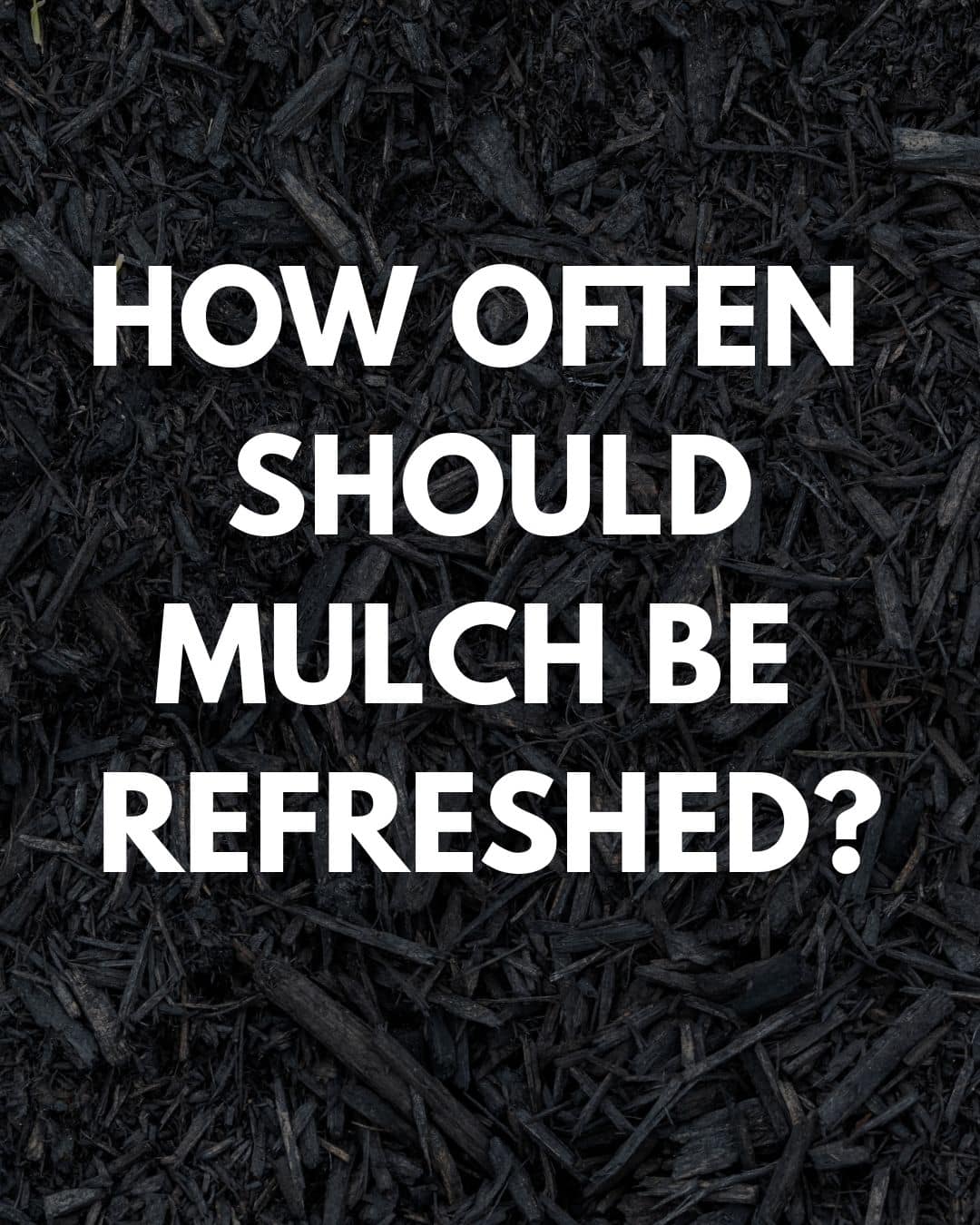If your mulch is faded, patchy, under 2 inches deep, or no longer holding moisture and blocking weeds, it’s time to refresh. A quick inspection of color, depth, and performance gives you everything you need to know.
How Do I Know If I Need More Mulch?
Your mulch may be working harder—or less effectively—than you think. It’s easy to forget about it once it’s down, but mulch is more than decoration. It’s a living part of your landscape that breaks down, shifts, and fades over time.
If you’re wondering whether you need to re-mulch, you’re not alone. Here’s how we, as landscaping professionals, evaluate mulch beds to know exactly when a top-up is needed, what kind, and how much.
🌱 Why Mulch Matters More Than You Realize
Before we jump into signs it’s time to refresh, here’s a quick reminder of why mulch is critical:
-
Suppresses weeds by blocking sunlight to seeds
-
Retains moisture and reduces the need for constant watering
-
Regulates soil temperature, protecting roots from heat and cold
-
Prevents soil erosion during heavy rains
-
Improves soil quality over time as it breaks down
-
Boosts curb appeal with a clean, finished look
But mulch doesn’t last forever — and ignoring it leads to more weeding, more watering, and more work.
🔍 1. Check the Depth — This Is the Big One
Mulch should be about 2 to 3 inches deep.
Less than that, and:
-
Sunlight reaches the soil, encouraging weed growth
-
Moisture evaporates faster
-
Mulch won’t insulate plant roots properly
More than 3–4 inches? That’s a problem too. Over-mulching can:
-
Suffocate roots and trap excess moisture
-
Attract pests
-
Encourage root rot near stems or tree trunks
🧪 DIY Test:
Stick your fingers or a ruler into the mulch. If you hit bare soil before the 2-inch mark, you need more mulch.
If it feels compacted or hard like a crust, it needs to be loosened or replaced — even if it’s thick enough.
🎨 2. Look at the Color and Texture
Fresh mulch:
-
Is rich in color (deep brown, black, or red)
-
Smells earthy, not sour
-
Breaks apart easily when disturbed
Worn-out mulch:
-
Looks gray, pale, or washed out
-
Has a dried-out, flaky texture
-
May have mold, slimy patches, or visible compaction
Color loss doesn’t always mean mulch is ineffective, but it often signals age and reduced performance. If it’s been more than 10–12 months, a color-refresh layer is often all that’s needed.
🌿 3. Weed Control Is Slipping
One of mulch’s main jobs is keeping weeds from sprouting — so if you’re pulling more weeds than usual, your mulch might not be doing its job.
You likely need more mulch if:
-
Weeds are sprouting through the mulch layer
-
Bare soil is visible in multiple areas
-
Edges around beds are overrun
This is especially true in July and August, when weed pressure peaks. A new 1–2″ layer can reset your weed control without needing to start over.
💧 4. Soil Is Drying Out Too Fast
If you water your beds and the soil dries out quickly, it might be time to re-mulch. Proper mulch helps slow evaporation, so your soil should stay consistently moist below the surface.
Signs your mulch isn’t holding moisture:
-
You see cracked, dusty soil between plants
-
Water beads off the mulch rather than soaking in
-
The mulch feels hot or dry to the touch, even below the surface
Tip: Water your bed and return 24 hours later. Dig below the mulch — if the soil feels bone dry, you’re losing moisture too quickly.
🧱 5. It’s Compacted or Matted Down
Over time, mulch can:
-
Get packed down from rain or foot traffic
-
Develop a crust that sheds water instead of absorbing it
-
Stop decomposing properly
This happens often with dyed mulch and very fine-textured products. Even if the depth looks right, compacted mulch acts like a barrier instead of a sponge.
Fix:
Rake or fluff it to loosen the top layer. If that doesn’t help, you may need to remove the old mulch and start fresh.
📅 6. It’s Been Over a Year Since You Topped Up
Even the best mulch naturally breaks down over time. Most organic mulches (like shredded hardwood, pine bark, or cedar) decompose over 12 to 18 months. If it’s been a full year since your last refresh:
-
Color and depth have likely diminished
-
Weed control is weaker
-
Soil underneath may be exposed or uneven
Annual mulch top-ups are standard in high-visibility areas, especially front yards, walkways, and curb appeal zones.
⚠️ Bonus: Mulch Is Up Against Plant Stems or Tree Trunks
This isn’t a sign you need more mulch — it’s a sign you need to fix what’s there.
Mulch should never touch:
-
Shrub or tree trunks
-
Woody plant stems
-
House siding or fences
Doing so invites rot, insect infestation, and fungal diseases. If your mulch is piled like a “volcano,” rake it back into a flat ring instead.
🛠️ What We Do for Clients During a Mulch Refresh
When we inspect a property and determine it’s time to re-mulch, here’s how we handle it:
-
Weed and clean out beds
-
Rake or remove old mulch as needed
-
Measure current depth to avoid over-mulching
-
Water beds before laying mulch if soil is dry
-
Spread fresh mulch evenly at 2–3″
-
Cut clean bed edges for a finished look
-
Taper away from trunks and stems
We also help clients choose the right type of mulch based on plant needs, sun exposure, and visual preference.
💬 FAQ: Knowing When to Re-Mulch
Q: Can I just rake old mulch instead of adding more?
A: If depth is still good and the mulch isn’t compacted or faded, yes. But if you’re seeing weeds, dry soil, or patchy spots, it’s time for more.
Q: How often should I add mulch?
A: Once per year for most landscapes, though high-traffic areas or light mulch types may need refreshing twice a year.
Q: What if I already have 4 inches of mulch?
A: That’s too much. Consider removing the excess before adding new. Over-mulching can suffocate roots and cause water issues.
Q: Can mulch go bad?
A: Yes. Old mulch can get moldy, slimy, or stop breaking down. If it smells sour or looks matted, it may need to be replaced, not just topped off.
Q: Is dyed mulch worse than natural?
A: Not necessarily. Dyed mulch holds color longer, but may fade unevenly or compact more. We help clients choose the best fit for their yard and goals.
🧼 Conclusion
You don’t need to guess whether your yard needs more mulch — just look, feel, and measure. If it’s thin, faded, compacted, or not doing its job, refreshing your mulch can dramatically improve your landscape’s health and appearance.
Want help evaluating your beds or getting mulch delivered and installed professionally? We’re here to help you make the smart call — and the smart layer — that keeps your yard in top shape all season long.

